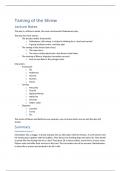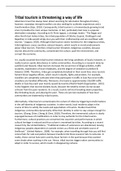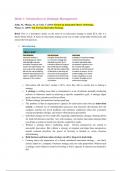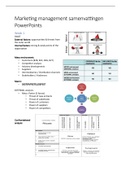All lectures and compulsory articles of Consumer behavior and Sustainability
Lecture 1
Normative Decision Theory
Normative theories
→ “concerned with the nature of rationality and the logic of decision-making”
Descriptive theories:
→ “concerned with people’s beliefs and preferences as they are, not as they should mbe”
Rational choice theory: basic axioms
Expected value theory: decision-making under risk
Rational choice theory
➔ People have stable preferences
➔ People consider costs and benefits of all option when making a decision
➔ People choose the option that maximized their benefits
Transitivity
- If A > B and B > C then A > C
Dominance
- If A and B are equally good on all dimensions
- Except one where A is better
- Then A should always be preferred
Invariance
- preferences should not depend on the way they are described
Perfect information processing
Selfishness
People often deviate from the principles of rational choice theory
(e.g. starbucks koffie: klein 2,50 medium 3,50 → kiezen voor medium. Klein 2,50, medium 3,50 en
large 5,00 → ook medium kiezen)
Preferences are influenced by context
Compromise effect: an option is chosen more often when its attributes are not at the extremes
Attraction effect: option a is more strongly preferred over option B if A obviously dominates another
option ( popcorn small 3,50, medium 6 en large 6,50)
People sometimes:
- avoid information
, - rely on “bad” information
- ignore “good” information
People are not always selfish
Expected value theory
Used to describe the expected outcome of risky choice
- multiple possible outcomes
- each outcome has a probability of happening
Examples: gambling
- investing money
- buying a product / service
- asking someone out on a date
- moving to a different city
- choosing a job
How to calculate expected value?
- value of each outcome
- probability of each outcome
- multiply value by probability
- add it all up to get EV
A proposed gamble
- heads: you pay me 10 euros
- tails: I pay you 1 euro
What is the expected value?
- outcome 1: heads = (0,5 x -10) = -5
- outcome 2: tails = (0,5 x+1) = +0.5
- -5 + 0.5 = - 4.5 euros
Should you take the gamble? Weigh option
Expected value theory:
, - people calculate expected value
- then choose the option with the highest EV
People deviate from EV
- St. Petersburg paradox (1713)
Expected utility theory
- value = / (niet gelijk aan) value ; personal preference matter
- people maximize expected utility
Summary
Normative theories describe how decisions should be made
RCT:
- people are selfish
- people are rational
- = people will maximize their personal benefits
EVT/EUT
- people assign utility + probability to each outcome
- … and pursue the outcome with the highest expected utility
These theories are useful but often fail at description
Lecture 2
Descriptive decision theory
Recap:
Normative vs descriptive theories
Normative theories (Rational Choice Theorie, Expected Utility Theory)
→ people maximize expected utility (=selfish)
→ utility & probability (=EU) is all that matters
→ people often violate these assumptions
Agenda for today:
- Defenses of normative theories
- Descriptive decision theory
- prospect theory
In defense of normative theories:
● “As if”
○ people may not go through the mental steps
○ but they still chose in line with theoretical predictions
○ people behave as if they are maximizing utility
, But: choices don’t conform to theoretical predictions
● Random errors
○ small deviations from rationality
○ deviations are random
○ they average out on the aggregate
But: deviations are systematic
● Incentives & learning
○ critique of experimental methods
○ people need proper incentives
○ people need a chance to learn
But: “Irrational” behavior even with proper incentives with learning, and among experts
Behavioral economics
Behavioral economics:
- attempt to build descriptive theories of economic decision-making
- observe how people actually make decisions
- lab experiments
● Heuristics & biases program
○ Kahneman & Tversky
○ They actually looked at what do we know about humans psychology, how the mind
works → in decision making
○ Psychological principles
○ Biases: systematic deviations from rationality
○ Heuristics: mental short-cuts
● Prospect theory
○ how people make risky choices
○ alternative to expected utility theory
○ value function
■ how people value gains and losses
1. reference point
2. diminishing sensitivity
3. steeper loss function
Reference point:
- there’s no absolute value
- everything is valued in comparison to some reference point
E.g. You spend a day at the casino and win 5 euros
How happy are you?
You spend a day at the casino and win 1 million euros. The, at the last minute, you 999,995
Lecture 1
Normative Decision Theory
Normative theories
→ “concerned with the nature of rationality and the logic of decision-making”
Descriptive theories:
→ “concerned with people’s beliefs and preferences as they are, not as they should mbe”
Rational choice theory: basic axioms
Expected value theory: decision-making under risk
Rational choice theory
➔ People have stable preferences
➔ People consider costs and benefits of all option when making a decision
➔ People choose the option that maximized their benefits
Transitivity
- If A > B and B > C then A > C
Dominance
- If A and B are equally good on all dimensions
- Except one where A is better
- Then A should always be preferred
Invariance
- preferences should not depend on the way they are described
Perfect information processing
Selfishness
People often deviate from the principles of rational choice theory
(e.g. starbucks koffie: klein 2,50 medium 3,50 → kiezen voor medium. Klein 2,50, medium 3,50 en
large 5,00 → ook medium kiezen)
Preferences are influenced by context
Compromise effect: an option is chosen more often when its attributes are not at the extremes
Attraction effect: option a is more strongly preferred over option B if A obviously dominates another
option ( popcorn small 3,50, medium 6 en large 6,50)
People sometimes:
- avoid information
, - rely on “bad” information
- ignore “good” information
People are not always selfish
Expected value theory
Used to describe the expected outcome of risky choice
- multiple possible outcomes
- each outcome has a probability of happening
Examples: gambling
- investing money
- buying a product / service
- asking someone out on a date
- moving to a different city
- choosing a job
How to calculate expected value?
- value of each outcome
- probability of each outcome
- multiply value by probability
- add it all up to get EV
A proposed gamble
- heads: you pay me 10 euros
- tails: I pay you 1 euro
What is the expected value?
- outcome 1: heads = (0,5 x -10) = -5
- outcome 2: tails = (0,5 x+1) = +0.5
- -5 + 0.5 = - 4.5 euros
Should you take the gamble? Weigh option
Expected value theory:
, - people calculate expected value
- then choose the option with the highest EV
People deviate from EV
- St. Petersburg paradox (1713)
Expected utility theory
- value = / (niet gelijk aan) value ; personal preference matter
- people maximize expected utility
Summary
Normative theories describe how decisions should be made
RCT:
- people are selfish
- people are rational
- = people will maximize their personal benefits
EVT/EUT
- people assign utility + probability to each outcome
- … and pursue the outcome with the highest expected utility
These theories are useful but often fail at description
Lecture 2
Descriptive decision theory
Recap:
Normative vs descriptive theories
Normative theories (Rational Choice Theorie, Expected Utility Theory)
→ people maximize expected utility (=selfish)
→ utility & probability (=EU) is all that matters
→ people often violate these assumptions
Agenda for today:
- Defenses of normative theories
- Descriptive decision theory
- prospect theory
In defense of normative theories:
● “As if”
○ people may not go through the mental steps
○ but they still chose in line with theoretical predictions
○ people behave as if they are maximizing utility
, But: choices don’t conform to theoretical predictions
● Random errors
○ small deviations from rationality
○ deviations are random
○ they average out on the aggregate
But: deviations are systematic
● Incentives & learning
○ critique of experimental methods
○ people need proper incentives
○ people need a chance to learn
But: “Irrational” behavior even with proper incentives with learning, and among experts
Behavioral economics
Behavioral economics:
- attempt to build descriptive theories of economic decision-making
- observe how people actually make decisions
- lab experiments
● Heuristics & biases program
○ Kahneman & Tversky
○ They actually looked at what do we know about humans psychology, how the mind
works → in decision making
○ Psychological principles
○ Biases: systematic deviations from rationality
○ Heuristics: mental short-cuts
● Prospect theory
○ how people make risky choices
○ alternative to expected utility theory
○ value function
■ how people value gains and losses
1. reference point
2. diminishing sensitivity
3. steeper loss function
Reference point:
- there’s no absolute value
- everything is valued in comparison to some reference point
E.g. You spend a day at the casino and win 5 euros
How happy are you?
You spend a day at the casino and win 1 million euros. The, at the last minute, you 999,995










